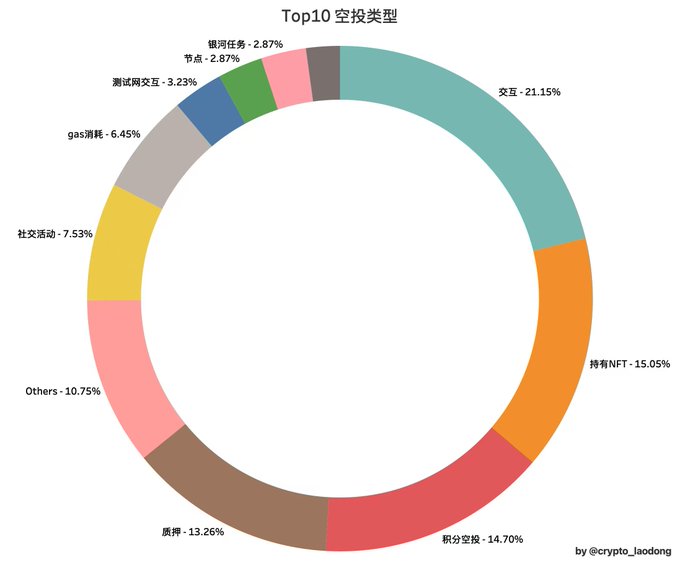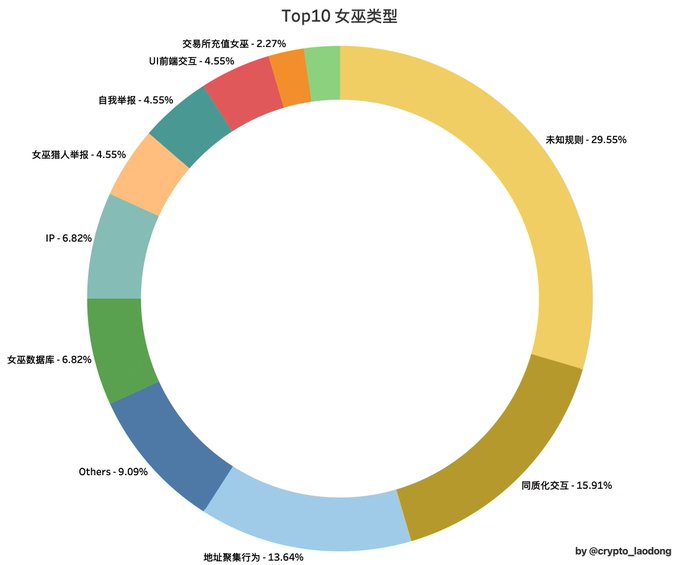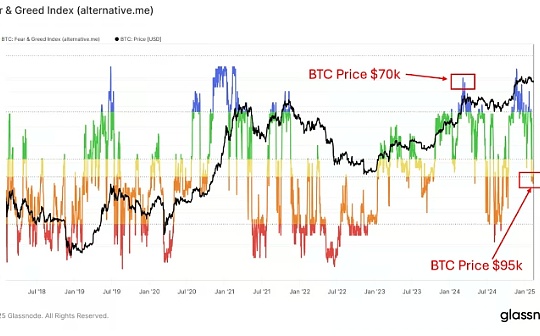Cruel status: Three major contradictions in the current airdrop market

Reprinted from chaincatcher
02/18/2025·2MAuthor: 0x Lao Dong
Preface
The current airdrop market has entered a naked competition for interests. While acquiescing data fraud to attract financing, the project party is cleaning up on a large scale before airdrops; the hair-fighting party is fighting desperately in the dilemma of "if you are not necessarily masturbating, there will be no masturbating." This game without referees exposed the sharpest contradictions in the airdrop market - the tear between data bubbles and real value, and the opposition between short-term interests and long-term ecology. Lao Dong used the airdrop data of 100 projects in 24 years to reveal the latest trends and rules of airdrops - who is harvesting? Who is being harvested?
A project party's goal conflict
Core contradiction: data growth demand (creating bubbles) vs. control token outflows (eliminating bubbles)
"We know that more than 80% of the addresses are studios, but they must rely on them to complete the ecological cold start" —— CTO of a certain L2 protocol
The project party faces a dilemma before TGE:
-
Bubble production with left hand : arranging studio batch brushing volume, manufacturing chain data boom (TVL/transaction volume/user number) to attract financing
-
Right-hand bubble cleaning : Filter the address before airdrop, perform large-scale cleaning
1. Airdrop type data analysis
Lao Dong sorted out the airdrop rules for 100 projects in 2024 and sorted out the proportion of various airdrop types:
Based on project data analysis, interaction, NFT holding, and points airdrop constitute the three mainstream mechanisms in the current market .
-
Interactive airdrop : The main airdrop method is mainly concentrated on the test network and the main network. The project party uses a series of tasks, such as Odyssey activities, to improve on-chain interactive data and TVL to attract financing, but too much interaction will lead to Project cleaning address. For example, LayerZero's 803,000 addresses were judged as witches, Linea's 40% of addresses were judged as witches, and StarkNet high-frequency interaction users were marked as robots
-
NFT holds airdrops : Secondly, NFT, OAT, etc. are often used as airdrop certificates, most of which require continuous tasks to be obtained, or spend funds on mint in the form of a whitelist. This type of NFT is usually circulating on the chain, which also creates potential risk of rat trading, which is difficult to identify, and the chips are centrally controlled (such as the NFTs of FUEL and Berachain, and the airdrop allocation ratio is unreasonable)
-
Point airdrop : The current mainstream method is different from tokens. Points are centralized data, with tampered and opaque nature. At the same time, unlimited issuance and the rules can be adjusted at will, making the fairness of the airdrop doubtful, such as ME (the points of the witch address are directly Clear zero, the exchange rate is also different) For example, linea (LXP belongs to SBT, which is also another form of points. If there are tokens, it may not be able to obtain airdrops in the end) points airdrop also have serious suspicion of rat trading (EigenLayer's snapshot storm, Blast’s additional points issuance and IO’s controversy over “shrinking points and stealing points” are all possible suspicion of rat trading)
Other airdrop types such as pledge, developer rewards, voting, etc. are also different ways for project parties to screen airdrop objects. However, the opacity of the rules, rat trading, insider information, etc. makes the fairness of the airdrop doubtful.
2. Market game and project party strategy selection
The current market is a stock game, and the cake is limited, and it cannot be done both and needs. The project party cannot satisfy the interests of itself, VC, users and exchanges at the same time. It must distribute interests and deprive value in the dynamic game. Faced with the contradiction of airdrop incentives, project parties usually adopt two typical strategies:
-
Sunshine type : Suitable for small projects or projects with sufficient rewards, such as HYPT, basically no filtering, and there is a reward for each address. This type of project is generally blind, without clear airdrop rules, cannot determine the odds, and it is difficult to attract a large number of studios.
-
Strict screening type : suitable for large projects, usually filtering users through points, interaction frequency, ranking, witch checking, etc., adopting the last-place elimination system. For example, strategies such as SCR (only 200 points or above have an investment space), runestone (through holding inscriptions and NFT screening), ZKsync and StarkNet (multiple condition screening), and Layerzero (witch reporting system) have improved the accuracy of reward allocation. , but it also increases the uncertainty of participation, making the hair-fighting party passive in the rules game
2. Participants’ mental conflicts
Core contradiction: If you don’t play, you will definitely not have vs. If you don’t play, you won’t have any
Participants also faced a dilemma:
-
If you don’t participate in the project at all , you will definitely not be able to get the airdrop reward. In order to strive for possible benefits, many users have to actively participate in various tasks and activities, invest a lot of time and resources, thereby further aggravating the market's inversion and participants' anxiety.
-
If you masturbate, you may not necessarily get rewards even if you invest more. User input is not proportional to output, and the project party filters the address through various means. The complex screening mechanism has caused many participants to lose their investment range due to strategy mistakes or being misjudged as witches.
1. Overcompetition and investment risks
In order to compete for limited rewards, users have to "make" a lot of data and activity, but at the same time, complex opaque rules and strict screening standards make it difficult for participants to predict their actual returns in 100 projects in 2024 . There are 32 witches . The screening standards of most project parties are not disclosed, and the review process is even more black box operation, and it is completely in the hands of the project parties. The user is like a lamb to be slaughtered and is arbitrarily judged. The following figure shows the analysis of the witch type:
The core basis for project parties to screen witches include:
-
Homogeneous interaction : a large number of similar operating modes are the main reasons why they are judged as witches
-
Address aggregation behavior : Multiple addresses perform similar operations at the same time and in the same environment, which are easily identified and cleared.
-
IP, device, and front-end interaction : More and more project parties analyze user behavior through front-end data, making it difficult for the confrontation strategy of simply changing IP and changing devices to work
If you want to survive this airdrop game, capital and luck alone are far from enough. You also need more sophisticated interactive strategies, stronger technical support, higher anti-reconnaissance capabilities, and continuous investment and persistence.
The conflict between the three project parties and the hair-fucking party
Core contradiction: one loss and both losses VS one prosper
In the game of airdrop incentives, a "symbiotic" relationship has been formed between the project party and the hair-beating party, and their destinies are closely linked to each other:
-
Co-prosperity : When both parties reach a relatively balanced incentive mechanism, it can not only attract sufficient active data, but also ensure ecological quality, so that both the project party and the user can benefit from it;
-
Collective damage : If either party is imbalanced, whether the project party’s airdrop strategy is inappropriate or the hair-fighting party’s excessive volume brushing will eventually have a negative impact on the entire ecosystem, and both parties will find it difficult to survive alone.
Dynamic game:
-
When participating in airdrop activities, the project usually sets certain thresholds. For example, Linea's POH certification and IP territorial threshold. When the project party sets a looser threshold for participation, the hair-beating party can participate in a large amount, forming a situation where data surges in the short term. However, once this bubble effect is cleaned by a strict screening mechanism, the entire ecosystem may fall into serious data and actual user activity. The dilemma of disconnection. For example, after LayerZero announced that the number of active addresses on the chain fell sharply.
-
On the contrary, when designing the rules, the project party raised the threshold for participation to ensure that only users who are truly active and contributed real value can receive rewards. Although such a high threshold will not increase rapidly in the short term, it will cause the active addresses on the chain to grow healthily and steadily, avoiding the emergence of data bubbles.
The essence of airdrop is a dynamic game of interests between project parties and users. For the hair-bearing party, if you want to get profits steadily, you must refine your strategies, improve your interaction quality, and even build long-term value; for the project party, you should not deliberately pursue financing, go to the big institute, and your core tasks are not It should be how PUA users create short-term prosperity, but how to build a long-term sustainable ecosystem to truly provide value support.





 jinse
jinse

 panewslab
panewslab